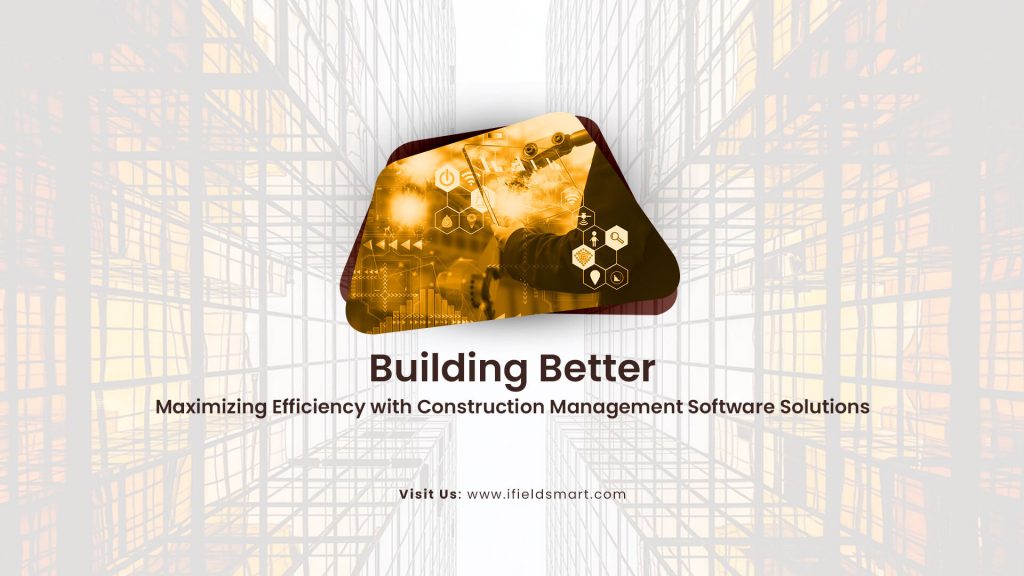Reading Time: 6 minutes
Efficiency within the construction landscape points to accomplishing tasks, processes, and projects with minimum effort, resources, and time. This improves productivity and ensures positive outcomes. In the construction industry, efficiency is critical to meet project timelines, achieve planned costs, and produce high-quality outcomes.
Introduction.
Efficiency in construction highlights a comprehensive approach to construction project management that includes various parameters including costs, labor, time, quality, and resources. Prioritizing efficiency helps construction companies augment productivity, profitability, and client satisfaction while upholding project sustainability within the construction industry.
Based on a report by Kings Research, the construction management software market will reach $21.67 billion by 2030.
Source: https://www.kingsresearch.com/construction-management-software-market-146
Work Smarter, Not Harder
iFieldSmart empowers your team with AI-driven efficiency to simplify scheduling, boost collaboration, and keep projects on track.
Schedule a MeetingConstruction management, like any other initiative, can face inefficiencies that can impede project progress. Mentioned here are the top 5 reasons why construction management becomes inefficient.
Five Key Factors Leading to Inefficiencies in Construction Management.
- Substandard communication and collaboration
- Insufficient planning and scheduling
- Lack of technology utilization
- Unclear roles and responsibilities
- Inadequate risk management
Substandard communication and collaboration
Fragmented or unclear communication leads to misunderstandings, problems in decision-making, and conflicts. These issues are observed due to miscommunication between Architects, contractors, sub-contractors, engineers, and other participants.
Insufficient planning and scheduling
Inefficient construction project management stems from unsatisfactory planning and scheduling. Inaccurate plans, unrealistic schedules, and inadequate resources lead to delays, cost overages, and rework. Failure to identify these risks in the initial stages can create major setbacks.
Lack of technology utilization
Manual and paper-based processes and tools for document management, budgeting, scheduling, and reporting can be error-prone and time-consuming. Without the use of construction management software, BIM tools, and other digital solutions, teams can struggle to track project progress simplify workflows, and make informed decisions.
Unclear roles and responsibilities
When roles and responsibilities are not set, and tend to overlap, there can be issues in accountability leading to confusion and inefficiencies. Without clarity on deliverables and tasks, projects tend to stagger and move towards delays and quality problems.
Inadequate risk management
Construction projects are prone to risks that impact costs, timelines, and quality. Insufficient construction management often stems from inadequate assessment, risk identification, and mitigation techniques. Failure to identify and resolve risks like supply chain issues, regulatory changes, and unexpected site conditions can lead to disputes and delays.
Exploring the Top Five Efficiency Categories in Construction.
- Time efficiency
- Resource efficiency
- Cost efficiency
- Labor efficiency
- Quality efficiency
Time efficiency
Finishing projects within proposed timelines is critical to meeting client needs and reducing ambiguities. Time efficiency involves effective project planning, coordination, and scheduling to ensure tasks are completed efficiently and on time.
Resource efficiency
Construction projects are dependent on multiple resources including equipment, labor, materials, and cost. Resource efficiency involves the optimization of resources to mitigate waste, lower costs, and improve productivity
Cost efficiency
Cost efficiency is about realizing project objectives to minimize expenses and staying within planned budget limits. It also includes budget management, cost estimation and cost control through multiple stages of the construction process. Techniques to achieve cost efficiency include procurement optimization, value engineering, and cost control measures.
Labor efficiency
Labor efficiency points to workforce effectiveness and productivity in construction projects. This includes labor allocation optimization, training and support, and deployment of efficient processes reduces idle time and augments output.
Quality efficiency
While efficiency may focus on cost-effectiveness and speed, quality remains a crucial aspect of construction projects. Quality efficiency includes attaining high-quality results to reduce rework, ambiguities, and defects. It requires adherence to quality assurance, perpetual improvements, and industry standards.
Overall, construction efficiency includes a complete approach to construction project management including various aspects including cost, labor, time, resources, and quality. By making efficiency a priority, construction firms can improve productivity, client satisfaction, and profitability while managing competitiveness and sustainability.
Considering the top 5 benefits of construction project management software.
Project planning and scheduling :
Construction management software provides innovative tools for scheduling and project planning. Features like Gantt charts, resource allocation modules, and critical path analysis project managers can generate accurate schedules, identify dependencies, and allocate resources. This makes the planning process seamless to ensure tasks are completed in an efficient progression while improving resource usage.
Communication and collaboration :
Communication and collaboration are key for the success of construction projects. Construction project management software drives real-time communication between project teams, subcontractors, and other participants. Through unified or cloud-based software, project teams can share documents, updates, and changes in real-time, mitigating communication bottlenecks and lowering the chances of misinterpretations or issues.
Document management :
Construction projects include vast amounts of documentation that includes contracts, permits, drawings, and specifications. Managing this data manually is time-consuming and error prone. Construction management software provides resilient document management allowing users to store, organize, and access documents effectively. Version control features ensure participants get access to the most updated revisions to improve transparency and minimize risks.
Cost control and budget management :
Cost overruns are challenges within construction projects that result in sub-standard budget management and unforeseen expenses. Construction management software diminishes this risk with tools that include expense tracking, budget estimation, and forecasting accurate costs. By monitoring project costs in real-time and recognizing cost savings opportunities, project managers can make informed decisions and keep projects within planned budget limits.
Risk management :
Construction projects pose significant risks with factors that include labor shortages, weather disruptions, and supply chain issues. Construction management software supports participants by reducing risks through risk identification, assessment, and mitigation techniques. Early identification of potential risks early in the project lifecycle and applying mitigation strategies helps project managers minimize disputes or delays.
Top 10 questions before selecting construction management software.
- What are our key challenges that the software needs to address?
- What essential features does our team require?
- How user-friendly is the software, and what’s the learning curve?
- Is the software scalable for our current and future projects?
- Can it be customized to fit our unique workflows?
- How well does it facilitate collaboration among stakeholders?
- What reporting and analytics capabilities does it offer?
- How reliable and secure is the software’s data management?
- What are the total costs, including implementation and support?
- What is the provider’s reputation in the industry, and how responsive is their support?
Conclusion
To wrap it up, integrating construction management software solutions into your workflow isn’t about staying ahead in the industry; it’s about making your life easier. These tools are like a trusted partner, helping you navigate the complexities of construction projects with confidence. From coordinating schedules to tracking budgets and everything in between, they’re the secret ingredient to maximizing efficiency and turning your vision into reality. So, why wait? Dive in, explore your options, and start building better today!
Visit : www.ifieldsmart.com








